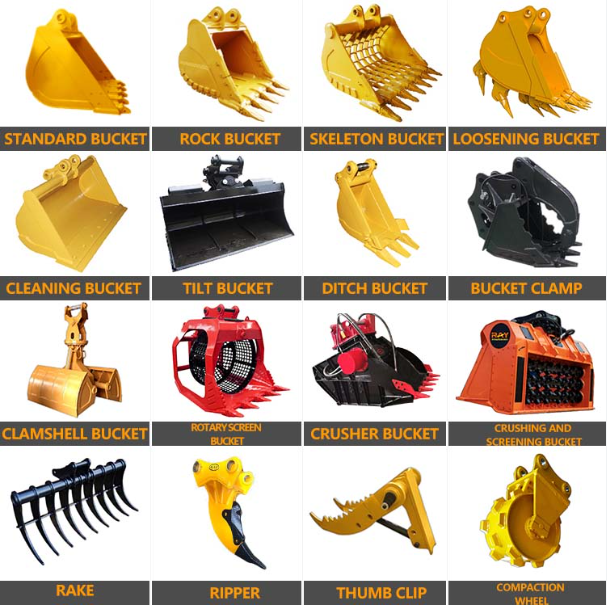Choosing the appropriate excavator bucket is a critical decision in construction and excavation projects. It’s akin to selecting the right tool for a specific task; the efficiency and effectiveness of the excavation work largely depend on it. Different Types of Excavator Buckets and Best Uses

The excavator bucket serves as the business end of the machine, determining how efficiently materials are dug, moved, and shaped. Whether it’s digging trenches, handling loose debris, shaping ditches, or tackling rocky terrain, the right bucket can significantly impact the project’s success, timeline, and cost-effectiveness.
Excavator buckets come in various types, each designed for specific tasks and conditions. From standard digging buckets and heavy-duty options to specialized buckets like rock and clamshell buckets, the variety can be overwhelming.
Standard digging buckets are the workhorses of excavators, versatile and widely used in a variety of excavation tasks. They feature a conventional design with durable teeth and a curved cutting edge. These buckets are available in various sizes to accommodate different machine sizes and job requirements. They excel in:
Heavy-duty digging buckets are engineered for demanding excavation conditions. They boast reinforced construction and robust teeth, making them suitable for tackling hard, compacted, or rocky materials. These buckets shine in:
Selecting between standard and heavy-duty digging buckets depends on the nature of the excavation job. Standard buckets are ideal for general digging and versatile material handling, while heavy-duty buckets excel in challenging environments and with tough materials. Properly matching the bucket type to the task ensures optimal efficiency and performance in excavation projects.
Cleanup buckets are designed for efficient handling and relocation of loose materials like soil, gravel, and debris. They feature a larger capacity and a wider profile compared to standard digging buckets, making them ideal for cleanup and land clearing tasks. Cleanup buckets are commonly used in:
Skeleton buckets have a grid-like structure with gaps between the tines or bars. This unique design allows them to sift and separate materials, making them particularly valuable for selective material handling. Skeleton buckets are used in:
Selecting the right material handling bucket depends on the specific requirements of the project. Cleanup buckets are ideal for quickly moving large volumes of loose material, while skeleton buckets excel in situations where precise sorting and separation are essential. Choosing the appropriate bucket type enhances efficiency and productivity in material handling tasks, contributing to successful project outcomes. Different Types of Excavator Buckets and Best Uses
Ditching buckets have a wide and shallow design, making them perfect for shaping ditches, channels, and drainage systems with precision. They’re characterized by their ability to create V-shaped bottoms in trenches. Ditching buckets are often employed in:

Tilt buckets are equipped with a hydraulic mechanism that allows them to be angled to the left or right. This versatility enables more precise grading and digging on uneven terrain. Tilt buckets are particularly valuable in:
V-shaped buckets have a distinctive narrow, pointed profile, ideal for digging trenches with a V-shaped bottom. They find extensive use in utilities and pipeline installation, where trench profiles are crucial. V-shaped buckets excel in:
The selection of shaping and grading buckets depends on the specific requirements of the project. Ditching buckets are perfect for creating ditches and channels, while tilt buckets provide the flexibility needed for grading uneven terrain. V-shaped buckets are indispensable for utility and pipeline work, where trench precision is paramount. Choosing the right bucket type ensures accurate shaping and grading in construction and landscaping tasks.
Rock buckets are built for durability and strength. They feature heavy-duty construction and reinforced teeth, making them ideal for handling rocky terrain and abrasive materials. Rock buckets excel in:
Clamshell buckets consist of two hinged buckets that open and close like a clamshell. They are typically used for digging and material handling in confined spaces, including deep excavations and underwater applications. Clamshell buckets are valuable in:
Various other specialized buckets cater to specific tasks, including:
The selection of specialized buckets depends on the specific project requirements. Rock buckets are essential for rugged terrain, while clamshell buckets excel in confined spaces and underwater scenarios. Specialized buckets cater to unique challenges, ensuring efficient and precise excavation in various specialized applications.
To sum it up, having a comprehensive grasp of the wide array of excavator buckets and their optimal uses is indispensable for boosting efficiency and productivity in construction and excavation endeavors. The choice of the appropriate bucket type holds the potential to greatly influence project outcomes, be it in digging, material handling, shaping, or specialized applications. Different Types of Excavator Buckets and Best Uses
Aligning the excavator bucket with precise job requirements and terrain characteristics empowers operators to maximize their machinery’s capabilities, ultimately leading to successful project outcomes. It underscores the significance of selecting the perfect tool for the task, elevating project efficiency, and conserving valuable time and resources.